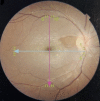Central retinal artery occlusion as a result of symptomatic patent foramen ovale
- PMID: 37089812
- PMCID: PMC10117189
- DOI: 10.22336/rjo.2023.12
Central retinal artery occlusion as a result of symptomatic patent foramen ovale
Abstract
Objective: The objective of this case report is to highlight the importance of patent foramen ovale (PFO) as a potential cause of central retinal artery occlusion (CRAO). Methods: A teenage girl presented with a sudden painless onset of vision loss in the right eye, which was accompanied by frontal headaches and vertigo. The patient was referred to the Ophthalmology Department, where subsequent examination revealed a best corrected visual acuity of 20/ 400 and a positive relative afferent pupillary defect (RAPD) in the right eye. Fundoscopy and optical coherence tomography confirmed the diagnosis of central retinal artery occlusion following which investigations to rule out hematologic, vascular, and cardiac causes were performed. Results: Transoesophageal echocardiography revealed PFO as the cause of this cryptogenic stroke. All the necessary blood testing work was performed (complete blood counts, erythrocyte sedimentation rate, C-reactive protein, lipid profile, homocysteine levels, prothrombin time, activated partial thromboplastin time, international normalized ratio, liver, renal and thyroid function tests, antinuclear antibodies, anti-smooth muscle antibodies, anti-mitochondrial antibodies, p-ANCA, c-ANCA, anti-cardiolipin antibodies, protein C, Protein S, activated protein C resistance, anti-thrombin III, VDRL, antibodies for viral retinitis, angiotensin converting enzyme, Mantoux test, detailed urine and electrolyte reports). Transoesophageal echocardiography revealed right to left shunt. Conclusions: This case along with other reported evidence in literature support the strong connection between PFO and CRAO. Closure of symptomatic PFO may result in prevention of severe visual loss. Abbreviations: CRAO = central retinal artery occlusion, PFO = patent foramen ovale, RAPD = relative afferent pupillary defect, BCVA = best corrected visual acuity, OCT = Optical coherence tomography, IOP = Intraocular pressures, TTE = transthoracic echocardiography, HM = hand motion, TEE = transesophageal echocardiogram.
Keywords: central retinal artery occlusion; patent foramen ovale; transesophageal echocardiography.
#x00A9; The Authors.Romanian Society of Ophthalmology.
Figures
Similar articles
-
Central retinal artery occlusion associated with patent foramen ovale: a case report and literature review.Arq Bras Oftalmol. 2021 Jul 14;84(5):494-498. doi: 10.5935/0004-2749.20210073. eCollection 2021. Arq Bras Oftalmol. 2021. PMID: 34320104 Free PMC article. Review.
-
Monocular central retinal artery occlusion caused by bilateral internal carotid artery hypoplasia complicated with patent foramen ovale: a case report and review of literature.Eur J Med Res. 2021 Jun 13;26(1):55. doi: 10.1186/s40001-021-00530-w. Eur J Med Res. 2021. PMID: 34120645 Free PMC article. Review.
-
Undiagnosed patent foramen ovale as a rare cause for branch retinal artery occlusion.Eur J Ophthalmol. 2015 Jul 30;25(5):e88-90. doi: 10.5301/ejo.5000608. Eur J Ophthalmol. 2015. PMID: 25837644
-
Retinal arterial occlusion and patent foramen ovale: A case study-based review.J Fr Ophtalmol. 2024 Jan;47(1):104021. doi: 10.1016/j.jfo.2023.07.022. Epub 2023 Nov 10. J Fr Ophtalmol. 2024. PMID: 37951744 Review.
-
Acute unilateral vision loss from central retinal artery occlusion associated with an atrial septal aneurysm and a patent foramen ovale: a case report.Fam Pract. 2021 Nov 24;38(6):834-836. doi: 10.1093/fampra/cmab050. Fam Pract. 2021. PMID: 34423829
Cited by
-
Ocular Manifestations and Complications of Patent Foramen Ovale: A Narrative Review.J Pers Med. 2024 Jun 27;14(7):695. doi: 10.3390/jpm14070695. J Pers Med. 2024. PMID: 39063949 Free PMC article. Review.
References
-
- Chronopoulos A, Schutz JS. Central retinal artery occlusion - A new, provisional treatment approach. Surv Ophthalmol. 2019;64:443–451. doi: 10.1016/j.survophthal.2019.01.011. - PubMed
-
- Chatziralli IP, Parikakis EA, Mitropoulos PG. Undiagnosed Patent Foramen Ovale as a Rare Cause for Branch Retinal Artery Occlusion. Eur J Ophthalmol. 2015;25:e88–e90. doi: 10.5301/ejo.5000608. - PubMed
Publication types
MeSH terms
LinkOut - more resources
Full Text Sources
Research Materials


